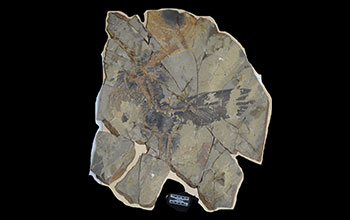Multimedia Gallery
New, tiny, bird-like dinosaur found (Image 2)
The slab of rock containing the fossil of Caihong juji, a tiny, bird-like dinosaur, included a nearly complete skeleton (brown) as well as feather impressions (black). [Image 2 of 3 related images. See Image 3.]
More about this image
Ancient dinosaurs could be adorned with some showy appendages, like the horns on Triceratops or the plates and spikes on Stegosaurus. Now, a newly discovered, chicken-sized dinosaur fossil from China contains evidence that could add a new accessory to the list: a shaggy ruff of rainbow feathers.
The dinosaur -- dubbed Caihong juji, which means "rainbow with the big crest" in Mandarin -- was discovered in 2014 in a slab of rock from China’s Hebei Province. The slab contained a nearly complete skeleton surrounded by impressions made by feathers. The impressions preserved the shape of melanosomes, microscopic wide, flat, pigment-containing packages. A team of researchers, including scientists from The University of Texas (UT) at Austin, compared the melanosome impressions to melanosomes found in living birds and found that they most closely resembled those in the iridescent, rainbow feathers of hummingbirds.
The team was the first to conduct an in-depth study of the dinosaur and describe it. The researchers believe the dinosaur used its flashy neck feathers and a bony crest on its snout to attract mates.
"Iridescent coloration is well known to be linked to sexual selection and signaling, and we report its earliest evidence in dinosaurs," said Julia Clarke, a professor in the Department of Geological Sciences at the UT Jackson School of Geosciences, who helped describe the new species. "The dinosaur may have a cute nickname in English, "Rainbow," but it has serious scientific implications."
Caihong is the earliest known dinosaur with asymmetrical feathers, the feather type found on the wingtips of modern birds that helps control flight. However, unlike modern birds, Caihong’s asymmetrical feathers were on its tail, not its wings, suggesting that early birds may have had a different steering or flight style.
"The tail feathers are asymmetrical but wing feathers are not, a bizarre feature previously unknown among dinosaurs including birds," said Xing Xu, a professor at the Chines Academy of Sciences and a co-author of a purblished description of Caihong juji. "This suggests that controlling [flight] might have first evolved with tail feathers during some kind of aerial locomotion."
Caihong is part of a group of small, bird-like dinosaurs that lived in China during the Jurassic, said Xu, but it stands out even among its closest relatives. While the other dinosaurs have bird-like, triangular skulls and long forearm bones in comparison to birds today, Caihong had a long and narrow skull, and unlike many of these other dinosaurs, its short forelimbs show proportions more akin to modern birds.
"This combination of traits is unusual," Clarke said. "It has a rather velociraptor-looking low and long skull with this fully feathered, shaggy kind of plumage and a big fan tail. It is really cool… or maybe creepy looking depending on your perspective."
The researchers say the next step is figuring out what factors influenced Caihong to evolve such a distinctive look, rainbow feathers and all.
[This research was supported in part by the National Science Foundation (grants EAR 12-51922 and EAR 12-51895).]
To learn more about this research, see the NSF News From the Field story Tiny dinosaur may have dazzled mates with rainbow ruff and a bony crest. (Date image taken: January 2018; date originally posted to NSF Multimedia Gallery: March 14, 2018)
Credit: Hu, et al., 2018
Images and other media in the National Science Foundation Multimedia Gallery are available for use in print and electronic material by NSF employees, members of the media, university staff, teachers and the general public. All media in the gallery are intended for personal, educational and nonprofit/non-commercial use only.
Images credited to the National Science Foundation, a federal agency, are in the public domain. The images were created by employees of the United States Government as part of their official duties or prepared by contractors as "works for hire" for NSF. You may freely use NSF-credited images and, at your discretion, credit NSF with a "Courtesy: National Science Foundation" notation.
Additional information about general usage can be found in Conditions.
Also Available:
Download the high-resolution JPG version of the image. (1.7 MB)
Use your mouse to right-click (Mac users may need to Ctrl-click) the link above and choose the option that will save the file or target to your computer.



